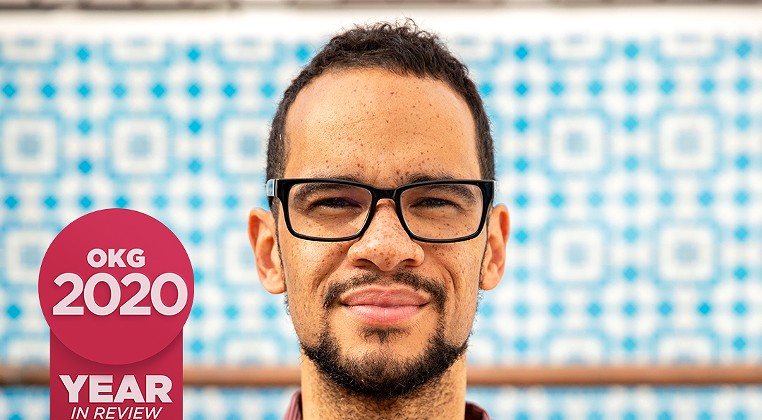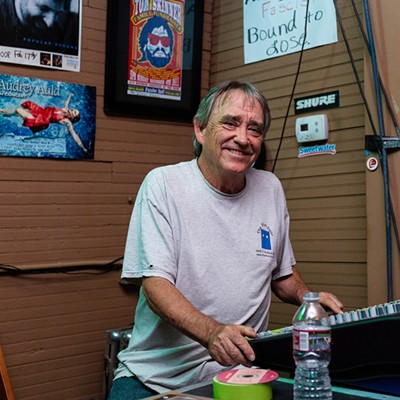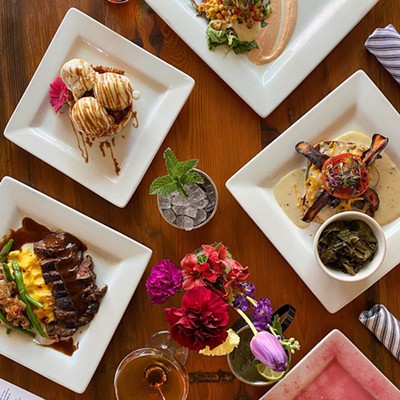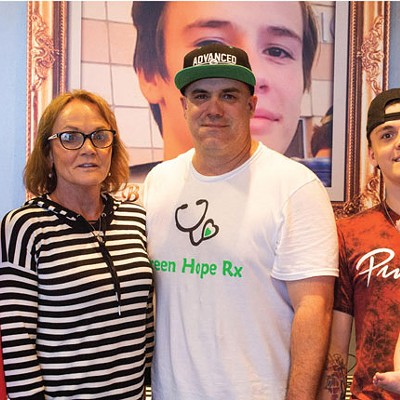
The day before the parade, however, OKC Pride comes downtown for the first time, moving its annual Pride Festival from Memorial Park to the Film Exchange District for a full day of live music, exhibitions, art and food.
The move downtown is not without significance for Oklahoma City and its LGBT community, according to Jeremy Crites, OKC Pride Festival co-chairman.
Sitting in Joey’s Pizzeria on Film Row, two blocks from the city’s new Devon tower, Crites explained, “Visibility is what our community needs if we are going to move ahead in Oklahoma City and in Oklahoma as a state. Coming downtown is a big part of that.
“Our city needs to know that we’re everywhere. We are your coworkers; we’re your neighbors. We go to your churches. We’re your friends; we’re your family.”
Graduating college in 2004, Crites, an Arkansas native, taught abroad in Europe before moving to Oklahoma City to be closer to family. He decided this year to join the all-volunteer OKC Pride Board to help coordinate the festivities.
“It’s great that once a year the whole community comes out in the tens of the thousands and proclaims who they are, and as a community, are proud of their identity,” he said.
The venue change for the festival is not the only break with tradition for OKC Pride this year.

Held every June since the first parade in 1987, this year’s OKC’s Pride Parade and Festival takes place in May in an attempt to avoid the summer heat from taking its toll.
Pride’s journey
While the Pride Festival makes its way downtown for the first time, OKC’s first gay-friendly establishment, Bishop’s Restaurant, called downtown “home” as early as the 1940s.
Describing Bishop’s in his 2006 dissertation, “The Emergence and Evolution of the Gay and Bisexual Male Subculture in Oklahoma City,” Rose State College history professor Aaron Bachhofer wrote, “Located across from the Skirvin Hotel, Bishop’s was famous for its Brown Derby steaks, shrimp cocktail, and walls covered with autographed celebrities.
“The wood-paneled walls and accent lighting gave the downtown establishment a classy touch and, in keeping with that theme, all the hostesses always wore proper ‘after-five’ attire, and some took modeling lessons.”
During the day, the restaurant on N.W. First Street operated as a straight establishment, a popular diner and one of the few downtown businesses with air-conditioning.
At night, however, Bishop’s transformed into the city’s leading nightspot for gay and lesbian residents.
Explained Bachhofer, “Located at the back of the restaurant, and running perpendicular to it so as to form an L-shaped building, was Bishop’s Tap Room, which first opened in 1938.”
It was here, seven nights a week, where gays and lesbians from across the city met for entertainment and to socialize.
“The
phenomenon of a club or restaurant being ‘straight’ during the day and
‘queer’ at night is not a new one,” wrote Bachhofer. “In
lesser-populated regions of the United States, especially after World
War II, gay men and women took advantage of any opportunity to socialize
in a comfortable environment.”
The
war marked a watershed moment for the nation’s LGBT citizens, as many
gay and lesbian Americans left their hometowns to serve their country.
For
the first time, gay and lesbian Americans met other gay and lesbian
people, learning that their same-sex attractions were far from abnormal.
Many
gay and lesbian American veterans opted not to return to their small
hometowns, choosing instead to live in the nation’s port cities where
urban anonymity offered them a chance to embrace their sexual identity
free from persecution and judgment.
In
OKC, however, the presence of Tinker Air Force Base in the 1940s meant
the city was a bustling spot for the military, and thus, gay and lesbian
Oklahomans.
Still,
homosexual sex acts were illegal until 1971 in every state but Illinois,
a fact not lost on OKC’s gay and lesbian population.
Overcoming fear
Throughout
the 1960s, Oklahoma County District Attorney Curtis Harris had OKC
police frequently raid gay and lesbian establishments, often during an
election campaign, arresting those inside to show voters he was tough on
“vice.”
Among
those arrested was Paul Thompson. After police arrested him in a
gay-friendly bar for kissing three friends on the back of their necks
(specifically, for “lewd” and “lascivious” behavior), Thompson spent the
night in jail, hired a lawyer, and went to court.
The
judge found the interpretation of “lewd” and “lascivious” too
subjective, and thus, unconstitutional. The charges were dismissed.
“It
was the first time that it had ever happened for a gay person in OKC,”
Thompson said in an interview before his death in 2010. “No one had ever
fought it before; they just thought we were lower than pond scum and
deserved all the abuse we could get.”
That
same year, on June 28, 1969, a police raid on the Stonewall Inn, a
popular gay bar in New York City, erupted into violent street protests
lasting several days after bar patrons and drag queens fought back
against months of police harassment.
The
Stonewall riots redefined the modern gay and lesbian movement
worldwide, giving way to an increased visibility in the 1970s for people
finally willing to come out of the closet and carve a public space
where previously none existed.
When
Angles opened its doors in September 1982 on the corner of N.W. 39th
and Pennsylvania Avenue, the gay club routinely drew packed crowds.
Overnight, the city’s gay and lesbian community went from barely
having a handful of gay bars to boasting a world-class dance venue. With
other bars already located on the same block, Angles changed the
fundamental character of N.W. 39th Street.
For
four months, the city’s police department harassed Angles’ gay and
lesbian patrons, citing the bar for phantom city ordinances and
unleashing a campaign of physical violence.
In
February 1983, Angles’ owners sued Oklahoma City. The city reportedly
settled the lawsuit seven months later, agreeing to provide
gay-awareness training for its officers and to obey a permanent
injunction against the OKC police coming onto N.W. 39th Street and
harassing the gay community.
Today,
several gay bars call The Strip home, including a country-and-western
bar, an after-hours dance club for the under-21 crowd, and The Boom,
which features dinner theater and Sunday brunch. Earlier this year,
Beans & Leaves, a gay-friendly coffee shop, opened its doors in the
area.
A place in OKC history
The
Strip is located on Route 66, and as the city’s LGBT community comes of
age in the 21st century, questions remain as to just what to do with
the area, particularly as the Pride Festival moves downtown.
“If
you ask me personally, I’d love to see landscaping down Pennsylvania
Avenue leading up to [The Strip],” said Georgie Rasco, executive
director of The Neighborhood Alliance of Central Oklahoma.
Rasco described a vision of N.W.
39th
Street that includes “better street lighting and more decorative kinds
of street lighting, maybe decorative benches on the sides of the road,
different kinds of businesses, an art store or other types of retail
outlets that could be up and down the street … anything that brings in
people during the daytime.”
“A
lot of people in the community have already done the bar scene; that’s
not the scene they’re in anymore. I think it’s important for other
people in our city to realize that the bars are not all the community is
about. It’s also about families and bringing your straight family
members and friends to [The Strip] and going to have a cup of coffee or
something.”
The Boom owner and OKC Pride President John Gibbons shares Rasco’s vision for The Strip.
“This
is where the community gathers to play,” he said, explaining that he’d
like to see the area take shape as an entertainment district similar to
the Paseo, the Plaza, or Midtown. “It absolutely has to happen here.”
Gibbons
recalled how the businesses on the northwest corridor of Western Avenue
came together to raise their property taxes to pay for the sorts of
neighborhood improvements that he’d like to see, and he remembered how
the community came together to fight HIV/AIDS in the 1980s and the ’90s.
“But
what is it going to take to keep us all down here?” said Gibbons. “It’s
going to take acceptance of the straight community being very much a
part of us.”
Hey! Read This:












